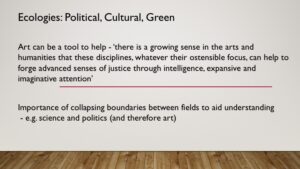
While we may have seen photographs of melting icebergs, we rarely have a physical experience of these things. Art can present different and bold perspectives and feelings, giving a deeper reflection and making warming more than just a number on paper and a bold headline.
Through their artwork, these artists are shedding light on environmental issues and addressing the urgent climate change crisis, bringing abstract, ‘distant’ issues and attitudes towards nature to the public eye through their artworks.
Just as Bishop said: “the artist is conceived less as an individual producer of discrete objects than as a collaborator and producer of situations while the audience, previously conceived as a “viewer” or “beholder” is now repositioned as a co-producer or participant.
The artists intend to bring the ‘Arctic ice melt’, which is usually only seen on television, into the everyday life of the public, allowing people to experience the process of melting ice, in an attempt to draw attention to the issues of global warming and climate change.
Contemporary art can reveal issues and respond to the urgent climate change crisis through its creations, bringing abstract, ‘distant’ issues and attitudes towards nature to the public’s attention through artworks.

Art. When we hear that word, some of our minds jump to museums or framed paintings. But really art is for anyone who wants to experience it.
Many believe that art is anything that stirs emotion in you. Now, the emotions that get stirred up depend entirely on your own history, your story, everything that comes together to make up who you are.
As mentioned in the video, we are aware that the world of art and culture. Art has always helped us see the world in new ways and generate new ideas to the world of art and culture has to help us enormously, it’s very incredibly important.
It gives us the opportunity to tell stories, record history, and tap into our emotions in a way that few other things can.
Participatory art is a mixed-media, event-based art made by artists and participants. The practice of action is a human interaction that reconnects individuals of different identities, classes and cultural backgrounds.
Artistic action is about engaging with the senses of reality and reshaping social consciousness, using events to transform the objecthood of the artwork, so that author and audience, individual and group, collide from symbols and desires, thoughts and feelings.
Just as Marx said: ‘People make their own history, but not under conditions of their own choosing’, so this artistic action must be produced by the combination of people in a particular social structure, historical context and their own experience.

The artist I would like to introduce is Olafur Eliasson.
His artworks all have a journey with the viewer, and through the link with these works, the viewer becomes part of the work, and in this way connects himself to himself, himself to art, and himself to the world.
Rather than allowing the public to view a work of art, he wants to make people feel it in a way that they can experience it directly and in a way that is palpable.
Perception and physical experience are the most important parts of art, and they can also act as tools for social change. We are all part of the ‘globalised us’ and we must all join together to create a stable climate for future generations.
The Weather Project is an immersive spatial work that offers a comfortable and friendly space where the viewer can rethink their social relationship with themselves and with the museum.
The viewer can sit, lie down, think, or practice yoga in this space, all sharing the same space despite their different ideas, just like the weather, which we share but no one really controls.In his lecture “light is life” he mentions.”
The Weather Project is a work that creates a spontaneous and personal experience for all viewers.
Art cannot be disconnected from the outside world; it is not a refuge from it and should never become an aesthetic utopia detached from the real world.On the contrary, the gallery is in fact an amplifier of our relationship with the world. In such spaces, we are able to examine our own relationship to the outside world – am I comfortable with my place in the world?
When we concentrate, we can hear, smell, touch and feel. Thus, in his work, the viewer’s senses can all come into play. This is the difference between reading an exhibition and seeing one.


Art not just about decorating the world, and making it look even better or even worse, Like he did here when throwing some green dye in the river, in los angels , Tokyo among other places, the green dye is not environmentally dangerous, but it obviously looks really rather frightening
As it somehow shows the turbulence in these kind of downtown areas, in these different places of the world. The green river, as a kind of activist, not a part of an exhibition, it was really about showing people in this city,as they walk by that space has dimensions.
A space has time and the water flows throughs the city with time . the water has an ability to make the city negotiable, tangible. Negotiable meaning that it makes a difference whether you do something or not . It makes a difference whether you say or do something, you will be a part of this city.
Through his artistic practice, the artist Eliasson wants to show that the art world actually has a lot of energy and can make some changes to the world.And thw artist can into the public space to create in a truly existing culture.


Leave a Reply